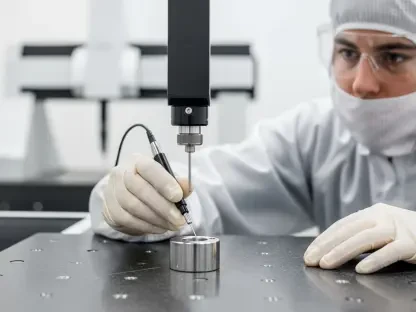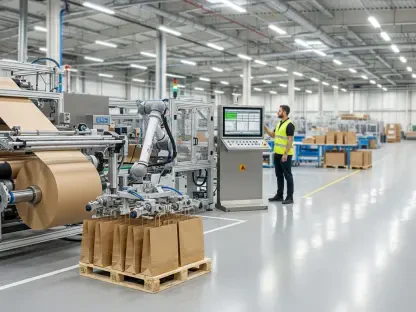Setting the Stage for Transformation in Pharmaceutical Manufacturing
In an era where pharmaceutical manufacturing faces unprecedented disruptions—from supply chain bottlenecks to regulatory pressures—a staggering statistic emerges: nearly 60% of pharma companies report significant downtime due to equipment failures annually, highlighting a critical need for innovative solutions. This vulnerability underscores the urgency for technologies that can fortify operational stability in a high-stakes industry. Digital twins, virtual replicas of physical plants powered by artificial intelligence and real-time data, are stepping into the spotlight as a game-changing technology. This market analysis explores how digital twins are reshaping pharma plant resilience, delving into current trends, adoption patterns, and future projections. By examining the intersection of technology and manufacturing, the goal is to uncover strategic insights for stakeholders aiming to navigate an increasingly complex landscape with agility and foresight.
Market Trends: The Rise of Digital Twins in Pharma
Adoption Surge Amidst Industry Challenges
The pharmaceutical sector is witnessing a notable uptick in the adoption of digital twins, driven by the urgent need to address operational inefficiencies and external disruptions. As supply chain interruptions and geopolitical tensions continue to challenge traditional models, companies are turning to these virtual simulations to enhance decision-making and minimize risks. Collaborative efforts, such as those between research institutions in Singapore, have accelerated the development of platforms that integrate AI and cloud technology, making digital twins more accessible to manufacturers of varying scales. Market data suggests that adoption rates have grown by over 30% in the past two years among large-scale pharma firms, with mid-sized players beginning to follow suit as costs decrease.
Predictive Maintenance as a Key Driver
A primary factor fueling market growth is the capability of digital twins to enable predictive maintenance, a feature that significantly reduces unplanned downtime. By leveraging real-time sensor data and anomaly detection algorithms, these systems can forecast equipment failures before they occur, extending machinery life and slashing maintenance costs. Industry reports indicate that firms implementing such technology have seen downtime reductions of up to 25%, translating into substantial savings. This trend is particularly pronounced in regions with high regulatory oversight, where minimizing operational hiccups is critical to maintaining compliance and market competitiveness.
Integration with Digital Factory Initiatives
Another emerging pattern is the integration of digital twins into broader digital factory frameworks, where fully connected, technology-driven environments are becoming the norm. This shift is propelled by the demand for agility in production processes, as manufacturers seek to reconfigure operations swiftly in response to market dynamics. Digital twins serve as the backbone for virtual process design and validation, reducing the reliance on costly physical trials. Analysts predict that by 2027, over half of major pharma plants will incorporate digital twins as a core component of their digital transformation strategies, signaling a robust growth trajectory for this technology.
Market Data and Projections: A Closer Look at Growth Potential
Current Market Penetration and Investment
As of now, the market for digital twins in pharmaceutical manufacturing is valued at several hundred million dollars globally, with significant investments pouring in from both private and public sectors. North America and Europe lead in adoption, accounting for nearly 60% of the market share, due to their advanced technological infrastructure and stringent quality standards. However, Asia-Pacific regions are emerging as high-growth areas, driven by increasing manufacturing hubs and supportive government policies. Investment in cloud-based platforms, which enhance the scalability of digital twins, has surged by 40% since last year, reflecting confidence in long-term returns.
Future Growth Forecasts and Barriers
Looking ahead, market projections estimate a compound annual growth rate (CAGR) of over 20% for digital twin technologies in pharma from 2025 to 2030. This growth is expected to be fueled by advancements in AI algorithms and the decreasing cost of sensor technologies, making implementation feasible for smaller players. Nevertheless, barriers such as high initial setup costs and a shortage of skilled personnel to manage these systems remain significant hurdles. Overcoming these challenges will be crucial for widespread adoption, particularly in developing markets where budget constraints are more pronounced.
Sustainability as a Value Proposition
An intriguing aspect of market dynamics is the growing recognition of digital twins’ role in promoting sustainability—a factor increasingly influencing investment decisions. By optimizing supply chains and supporting localized production, these technologies reduce transport-related emissions, aligning with global environmental mandates. Market analysis reveals that companies prioritizing green manufacturing are 15% more likely to adopt digital twins, as they seek dual benefits of resilience and reduced carbon footprints. This trend suggests that sustainability will become a key differentiator in the market over the next few years.
Strategic Implications: Navigating the Future of Pharma Manufacturing
Reflecting on the insights gathered, it’s evident that digital twins have marked a pivotal shift in how pharmaceutical manufacturing tackles resilience and efficiency. The technology’s ability to preempt equipment failures, streamline strategic planning, and support environmental goals has positioned it as an indispensable asset during a period of industry transformation. For stakeholders, the journey forward involves several actionable steps. Prioritizing pilot projects to test digital twin applications on specific production lines offers a low-risk way to evaluate potential benefits. Partnering with technology providers for tailored solutions and investing in workforce training ensures seamless integration and maximizes impact. Additionally, aligning digital twin strategies with broader sustainability objectives opens avenues for regulatory incentives and market goodwill. As the pharma landscape continues to evolve, embracing this innovation becomes not just a competitive edge but a cornerstone for enduring success in an unpredictable world.









